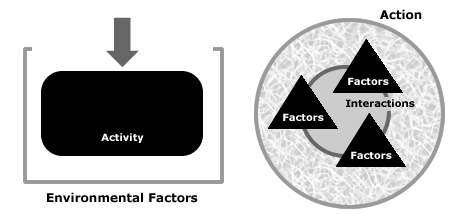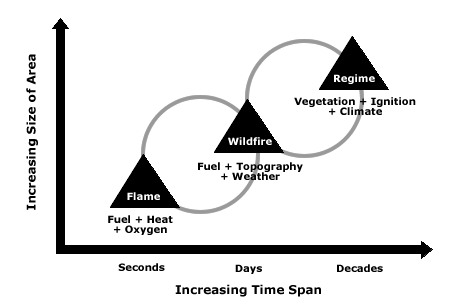Back in my days as a physicist, the world in which I lived was firmly deterministic. I believed that, if I knew enough about the mathematical formulas and the precise measurements of the world, the future could be controlled. Perhaps not the entire future, but I could manage the immediate future, as it pertains to the construction of things. It turns out determinism had been mostly dead quite a while in science; I had not yet read that chapter in the Big Book of Physics.
Disillusioned with the overwhelming nature of the math—and not relishing my own near future in high-energy physics—I turned about and headed the other direction, to the Theatre School. A dozen years later, I find myself coming full circle.
How CX informs HCI
Complexity, as it is preached at the IU School of Informatics, is the study of many-bodied systems achieving points of criticality where local interaction has long-range effects and emergent properties form at the system level. It is this last bit— emergence—that renews my hope to control the immediate future through design. Many parts with simple rules of interaction create a systemic structure that is not obvious from examining an individual component. I dub this fuzzy determinism because, while I can’t possibly measure or track every particle in a complex system, I can experiment through models and simulations to figure out what might emerge out of simple rules. Change a rule, get a different behavior.
Our HCI seminar is currently studying the history and theory of human-computer interaction, in particular work by Lucy Suchman. In the fourth chapter of her 1987 book, Plans and Situated Actions: The Problem of Human-Machine Communication, she describes action as an outcome of environmental interaction, rather than an intentional act shaping that environment. For Suchman, a plan of action is an opportunity to reflect on what has happened and anticipate what is to come. It has no direct impact on action since plans do not reside in the present. In this sense, the context of an action is the interaction itself: Action is not something constrained by other factors; it is the result of the combination of those factors.
I compare this to a notion from complexity, the highly-optimized tolerance (HOT) model. The creators of the concept — Jean Carlson (UC Santa Barbara) and John Doyle (CIT) — lent their voices to Max Moritz (Berkeley) to apply their work to the interactions of wildfires. In “Wildfires, complexity, and highly optimized tolerance,” Moritz’ 2005 article from the Proceedings from the National Academy of Sciences, talks about the relationship in scales of time and space between different levels of fire.
Burning as a situated action
A hot model is an attempt to evolve the scale-free network model to include multiple optimization goals. In other words, interesting things happen when a system of many parts tries to account for more than one thing at a time. A computer network, for example, grows by having new machines connect to it. When a new node enters a network, the best choice of where to connect is going to be the result of a trade-off between conflicting strategies. For greater connectivity, the new node’s path to to a central node should be short. For the smallest “last mile” costs of infrastructure, the physical distance to the network should be minimized. It is rare when both goals point to the same decision, so compromises are reached to optimize the nodes place in the system. Hot models can include any number of these factors in the calculation.
The real connection for me between Suchman and Moritz—and as someone trying to study both human-computer interaction and complexity, I am looking for such connections—is the example to which the hot model is applied: the spread of wildfires. Moritz borrows Countryman’s concept of a fire triangle to show how the action—burning—is dependent on the interaction between the environmental factors.
Firefighters embrace the triangle as a means of understanding the ingredients for wildfire. Topography is the shape of the physical landscape, including such things as elevation and slope. These properties can change suddenly, but there are no real internal dynamics with topography. The landscape generally stays the same. Weather is the opposite extreme, too complex to predict or control. There are many variables involved with weather, such as wind speed, temperature, and humidity, and is heavily influential on fuel’s ability to burn. It is fuel, the last component of the triangle, where firefighters direct their prevention plans. Although it, too, is dynamic, it is less so than weather and therefore intervention is more predictable.
Moritz applies this concept up and down the scale of time and space, using real data collected from different sources. In very small areas, on the order of seconds instead of days, the act is the flame and the factors are the interactions between oxygen, heat and fuel. In very larger areas, on the order of decades, the act is the fire regime and factors are climate, ignitions and vegetation. There is no wildfire without flame and no fire regime without wildfire. The climate is a long-term weather pattern, and the weather affects the amount of heat and oxygen available for combustion. In this sense, Moritz work echoes that of Suchman: the combination of environmental factors comprises the action, rather than the action itself interacting with the environment. Fire does not exist except under the right interactive conditions.
Complex Design
To me, this is the essence of situated action. The activity is dictated by those involved using the resources and personal experiences at their disposal. In the same way a wildfire has to wait until a flaming leaf is surrounded by ideal weather conditions and geography in order to spread widely across a forest, user actions must follow the context of the functions, interface tools, and interests of the person at the controls.

We tend to objectify the action as an embodied thing unto itself. It is as if we can take that action, put it in a box representing the conditions of the environment, and have it act a certain way. If we put that action in a different box, or put a different action in the same box, new things happen. Suchman’s way of looking at activity puts the context before the action. In fact, the factors that make up the environment are what creates the action. It is only after the action is over, and we have a chance to reflect on what has occurred, when we can objectify it enough to communicate.
Complex Design works in this way, only with many actions arising out of many combinations of user environments. I have given up on the flawed expectation of knowing enough about the specific actions to control use of the design, but fuzzy determinism changes the focus on the systemic behaviors that emerge from the cooperative actions. We design not for a single generalized user experience. We design for the impact many situated users have on each other. Like firefighters, we affect the outcomes at that higher level by thoroughly understanding the relationship between the contextual factors attached to the interface.
